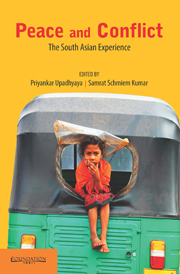Book contents
- Frontmatter
- Contents
- Foreword
- Preface
- Introduction
- 1 Conflict Resolution and Peacebuilding: Ideas, Approaches and Debates
- 2 Changing Perspectives on Peace Studies in South Asia
- 3 Peace Pedagogies in South Asia: Interreligious Understanding
- 4 Responses of Communities to Social Tension
- 5 Plurality of Peace, Non-violence and Peace Works in India
- 6 Education and Culture of Peace: Engaging with Gandhi
- 7 Structural Violence and Human Security: Gandhi's Visions
- 8 Women and the Peace Process in Nepal
- 9 Quest for Peace and Justice in Pakistan: Lawyers' Non-violent Resistance
- 10 Antinomies of Democracy and Peace in Nepal
- 11 Post-armed Conflict Trajectories in Sri Lanka
- 12 Environmental Security and Conflict in Bangladesh: Nature, Complexities and Policies
- Contributors
- Bibliography
- Index
8 - Women and the Peace Process in Nepal
Published online by Cambridge University Press: 05 October 2014
- Frontmatter
- Contents
- Foreword
- Preface
- Introduction
- 1 Conflict Resolution and Peacebuilding: Ideas, Approaches and Debates
- 2 Changing Perspectives on Peace Studies in South Asia
- 3 Peace Pedagogies in South Asia: Interreligious Understanding
- 4 Responses of Communities to Social Tension
- 5 Plurality of Peace, Non-violence and Peace Works in India
- 6 Education and Culture of Peace: Engaging with Gandhi
- 7 Structural Violence and Human Security: Gandhi's Visions
- 8 Women and the Peace Process in Nepal
- 9 Quest for Peace and Justice in Pakistan: Lawyers' Non-violent Resistance
- 10 Antinomies of Democracy and Peace in Nepal
- 11 Post-armed Conflict Trajectories in Sri Lanka
- 12 Environmental Security and Conflict in Bangladesh: Nature, Complexities and Policies
- Contributors
- Bibliography
- Index
Summary
Introduction
In the final two decades of the last millennia, there has been substantial increase in political violence (UCDP 2012). Such violence is mostly the product of intra-state rather than inter-state conflicts. This has meant that wars are no longer fought in the traditional sense of the term between states but often within the state and its own people. In this context, a cataclysmic development for women has been the inevitability of war happening in and around their homes. Acts of violence, however, may not always target the civilian populations, but women and children often get trapped in them. For want of ‘security’ from being ‘recruited’ or for the necessity of earning bread, men disappear to distant lands. Women, children, the aged and the infirm are thus exposed to violence from the state as well as from the insurgents or the non-state actors. The routine narrative is that of the silent suffering women are victimized in various ways. This to an extent is true. However, there is another side of the picture too: the agency hood of women. Women become actors in the theatre of war and also in peace.
This chapter aims at not only analysing the impact that war made on the lives of women in the recent violent conflict in Nepal, but also to emphasize on the complexity and multiplicity of women's role in war as well as in peace.
- Type
- Chapter
- Information
- Peace and ConflictThe South Asian Experience, pp. 140 - 159Publisher: Foundation BooksPrint publication year: 2014
- 1
- Cited by

